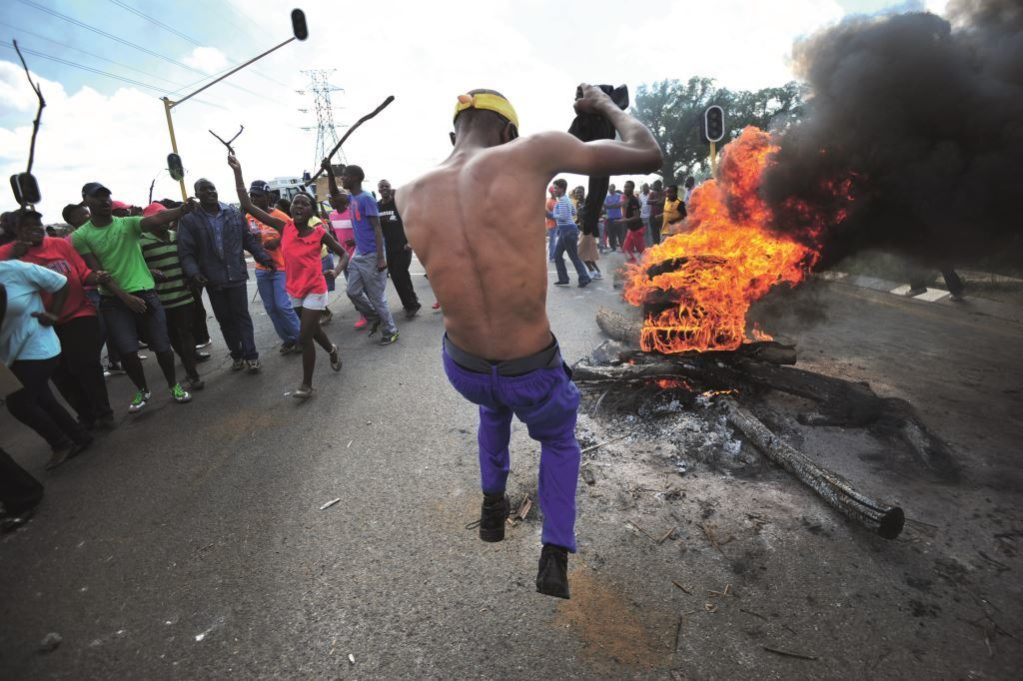They call it the Ring of Fire and in the last few years it has been getting hotter. This is the ring of sporadic protests around Johannesburg. The howl of the poor on the doorstep of one of the richest cities in Africa.
Most of these protestors vote and their dissatisfaction could signal a drop in support for the ruling ANC, which has guided South Africa through its 20 years of democracy.

The protests happen on different days, but follow the same pattern. Burning tires, rocks on the road and fighting between protestors and police. In many weeks, they are as frequent on radio as the traffic news.
The police struggle to control the unrest. Schools close their doors as demonstrators pelt police with stones and petrol bombs.
Loading...
Protesters burned down two of the Independent Electoral Commission’s voter registration stations in February.
In Gauteng, the province of Johannesburg, acting commissioner Lieutenant General Lesetja Mothiba says police saw 569 protest marches since November, of which 122 were violent.
“The South African public must realize what is confronting the members [police] on a daily situation while dealing with these issues of protest marches and demonstrations. These are not petty things, these are not issues that you can say ‘go read a book… and it will tell you how to deal with these issues’,” he says.
Gauteng premier Nomvula Mokonyane says the slow response to service delivery protests was leading to violence. She claims that opportunists, who lost out on government tenders, fueled some of the protests.
“Protests would not have happened if government responded quicker. Where violence happens we must act,” she says.
Research on service delivery protests by the Centre for Sociological Research, at the University of Johannesburg, suggests that, despite overwhelming support for the ANC, communities are frustrated with their ward councillors and local government.
Peter Alexander, the director of the center and South African research chair for social change at the university, says 60% of South African youth are unemployed, leading to discontent.
“The protests that swept across the country are not a novel occurrence on the social and political landscape. Impoverished residents of neglected townships have been voicing their dissatisfaction with ineffective and inadequate service delivery since the ANC rise to power in 1994,” says Alexander.
The communities involved in the cluster of service delivery protests share problems and frustrations. Poverty and unemployment are high. There’s a lack of water, sewage systems, street lighting, paved roads and housing.
“Many people don’t have the full range of service delivery, and they are continuously used as voting fodder in elections. Protests are about a range of issues, dominant to them is the youth unemployment. Their frustrations cannot be interpreted merely as a sign of displeasure with service delivery. Deeper discontent with available channels for participatory democracy underlies the protesters’ anger.”
The majority of protesters support the ANC. They are unhappy with their party because they believe the promises for a better life have not been fulfilled. To make the matters worse the government doesn’t understand, says Alexander.
In November, as Bekkersdal residents, west of Johannesburg, took to the streets to demand better government services, ANC veteran Winnie Madikizela-Mandela acknowledged that conditions in the area had not changed since 1994.
ANC deputy president Cyril Ramaphosa, campaigning for elections in Kagiso township in February, denied that service delivery protests were a sign people have abandoned the ANC.
President Jacob Zuma, in the state of the nation address in February, also downplayed the gravity of the recurring service delivery protests.
“The dominant narrative in the case of the protests in South Africa has been to attribute them to alleged failures of government. However, the protests are not simply the result of failures of government, but also of the success in delivering basic services. When 95% of households have access to water, the 5% who still need to be provided for feel they cannot wait a moment longer.”
Africa Check, a non-profit organization that promotes accuracy in public debate and the South African media, found that the figure differs between provinces. The president does not clearly define what he means by access to water, the most recent census claims that access is defined as either being inside a household, garden, or a communal tap in the street. Zuma’s claim does not speak of the quality of water—2.4% of Gauteng households said their water smelled bad in a 2012 household survey by Statistics South Africa. Nationally, 60% of households rated the quality of their water-related services as good.
Proof, that it all depends on which side of the protest you are shouting from.
Loading...
